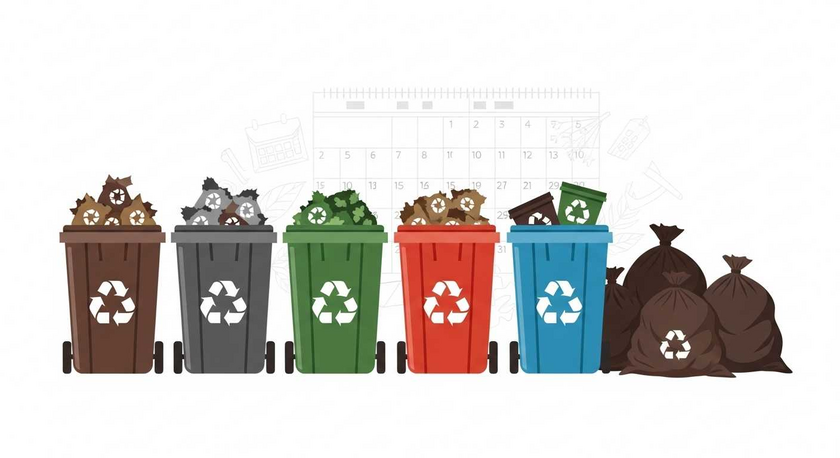Efficient waste management isn’t just about ‘set it and forget it’ curbside pickups—it’s about understanding how your lifestyle and the calendar intersect to shape the trash you generate. Whether you’re hosting holiday feasts, tackling spring cleaning, or taming summertime yard growth, each season brings its own surge of refuse.
By spotting those peaks early and applying a few simple tactics, you’ll avoid overflow headaches, keep costs predictable, and enjoy a tidier curb every week. In the sections that follow, we’ll dive deep into how to anticipate high-volume periods, match bin capacity, reduce waste through smart sorting, transform green waste into garden gold, and leverage expert audits for a truly holistic routine.
Anticipating the High-Volume Weeks
Before you can streamline your waste, you need to know precisely when it spikes. Most households see predictable surges:
Winter Celebrations: From Thanksgiving turkeys to Christmas wrapping paper, the final quarter of the year often sees a doubling or even tripling of normal trash output. Between food packaging, empty gift boxes, and discarded décor, a single pickup can leave carts overflowing.
Spring Decluttering: As temperatures rise, many families tackle basements, garages, and closets. That old treadmill, broken lawn chair, and decade-old sweaters all end up at the curb if you’re not strategic.
Summer Landscaping: Mowing season, gardening projects, and pool clean-outs generate mountains of organic debris, including grass clippings, hedge trimmings, and stray branches, that can quickly overwhelm a standard bin.
To capture these patterns, start a four-week “trash diary.” Each pickup day, record:
The number of standard trash bags you set out.
Any special events, such as parties, remodeling, or yard work.
Weather or holiday notes that might skew volumes.
After a month, you’ll see your average and your peaks.
Compare that against your calendar: are there specific weekends when you host family?
Do you plan a spring garage sale?
Highlight those high-output weeks and plot them on a seasonal chart. Armed with this data, you can decide whether to rent a small dumpster for a weekend project or simply request an extra cart for one month, ensuring that your trash service matches your actual needs without wasting capacity or incurring surprise overage fees.
Matching Your Bin Capacity to Your Peaks
Once you know when you’re likely to overflow, the next step is choosing the correct number of bins. Most households default to a single 96-gallon cart—enough for about 7–10 kitchen bags each week. however, when your trash volume spikes, a second or third cart can be more economical than paying overage fees or purchasing extra stickers.
Consider these scenarios:
If you host a holiday dinner that produces 15–20 bags in one week, adding a second cart at $45.95 per month (billed quarterly) can cost less than $10 in overage fees per extra bag.
For spring cleaning that requires 25–30 bags, a temporary roll-off dumpster rental (starting at around $200 per week) may be a more intelligent choice than upgrading your curbside service for an entire quarter.
During summer yard work, if you consistently use 12–18 bags per week after mulching and composting, a second cart can help smooth out your regular service without changing your pickup routine.
For a comprehensive, step-by-step breakdown of exactly how many 96-gallon carts your household needs—and how to cost-compare each option—see this guide on choosing the right trash cart size for your household in Ascension Parish. That resource guides you through a simple audit, provides price comparisons, and outlines when adding a cart truly pays off, so you can upsize or downsize with confidence.
Remember: it’s not “one size fits all” unless you know your size. Scaling your service up or down in lockstep with your actual usage keeps both your curb and your credit card statement clutter-free.
Sorting Smart: Fewer Bags, Bigger Impact
Adding capacity is one approach. Shrinking volume at the source is another—and often the more sustainable one. Here’s how to slash your trash output by 25–30% through everyday habits:
Compost Kitchen Scraps: Over 30% of household waste is organic. Keep a countertop bucket for fruit peels, coffee grounds, eggshells, and veggie scraps. If you have a backyard, start a simple pile or tumbler. No outdoor space? Many parishes offer weekly compost drop-off sites.
Rinse & Sort Recyclables: A dirty jar can spoil an entire recycling bin. Rinse plastic, glass, and metal containers before tossing them. Familiarize yourself with your parish’s recycling rules—some accept mixed paper, others require cardboard to be flattened separately.
Upcycle & Donate: Broken ceramics can be repurposed as garden décor, and old textiles can be cut into rags. For items still in good shape—such as clothing, furniture, and electronics—a local charity pick-up or drop-off center keeps perfectly usable goods out of the landfill.
By consistently composting, recycling, and donating, you’ll see a smaller pile of bags at the curb, resulting in fewer carts, lower fees, and a lighter environmental footprint. Additionally, these habits add only minutes to your routine but keep valuable resources in use rather than sending them to a landfill.
Turning Green Waste into Garden Gold
Yard debris can be the biggest seasonal headache, but it’s also your garden’s best friend when handled right:
Mulch Mowing: Set your mower blade to a high setting and let the clippings fall back onto the lawn. These micro-mulched clippings decompose quickly, returning nitrogen to your soil and reducing the volume of collection.
Branch Chipping: Small wood chippers are affordable to rent for a day. Turn hedge trimmings and pruned limbs into mulch that you can spread around flower beds, pathways, or at the base of trees.
Sticker Programs & Bulk Pick-Ups: Many parishes sell yard-waste stickers—often $2–$3 per bag—which allow you to supplement one or two extra yard bags per week without upgrading your cart plan. For larger piles, schedule a bulk pickup or haul to a parish compost site.
When you treat green waste as a resource instead of trash, you’re not only reducing your curbside volume but also nourishing your yard for free. That’s a win-win for your wallet and your landscape.
Insights from the Pros: Data-Driven Waste Audits
“Most homeowners plan around pickup days without ever knowing what really goes into the bin,” says waste-management specialist Dr. Elena Rivera. She advises an annual “waste audit” to recalibrate your service:
Repeat Your Trash Diary: Conduct the same four-week audit each spring and fall.
Analyze by Category: Note what percentage is food, packaging, yard waste, or bulky items.
Adjust Service Levels: If yard waste drops by 50% after adopting your sticker strategy, consider reverting to a single cart for half the year. If holiday trash jumps by 40%, pre-schedule an extra cart for November and December.
By letting data, not assumptions, guide your decisions, you’ll avoid both under-service (overflow and fees) and over-service (paying for unused capacity). Dr. Rivera emphasizes that minor tweaks—such as adding one cart for six weeks instead of an entire quarter—can save homeowners hundreds of dollars annually.
Bringing It All Together: A Smarter Waste Routine
When you weave these tactics together—calendar-based planning, right-sized carts, savvy sorting, green-waste repurposing, and pro-level audits—you transform waste from a weekly chore into a streamlined system. Start by marking your high-output weeks. Consult the Trash Rangers cart-sizing guide for precise capacity decisions. Adopt composting and recycling habits that reduce volume at the source. Revisit your audit twice a year to keep everything dialed in.
With this holistic, season-savvy strategy, you’ll enjoy fewer surprise fees, a consistently clean curb, and the satisfaction of knowing you’re doing your part for both your budget and the environment.
Ready to roll out your perfect waste plan? Dive deeper into calculators, checklists, and expert tips on the Trash Rangers blog—then watch your curbside chaos turn into curbside confidence.



















